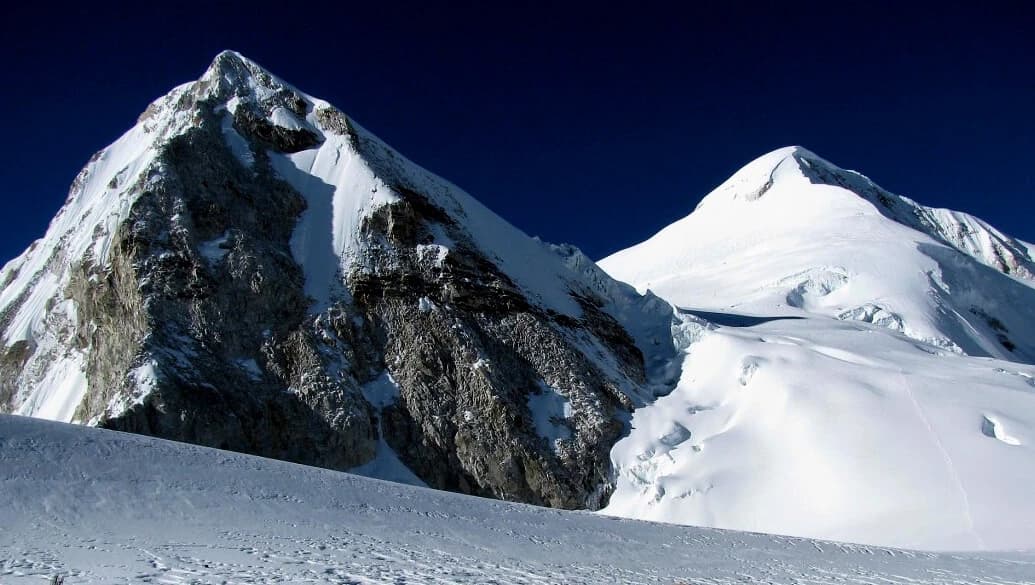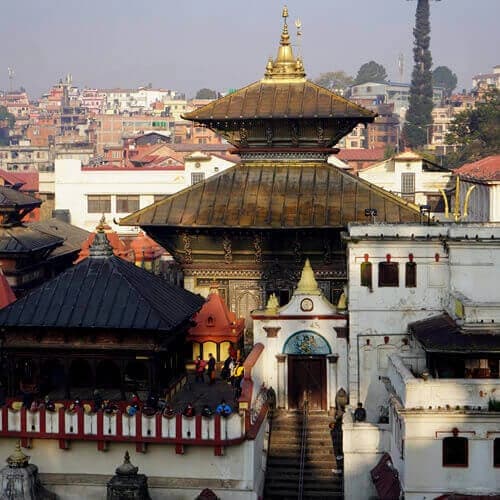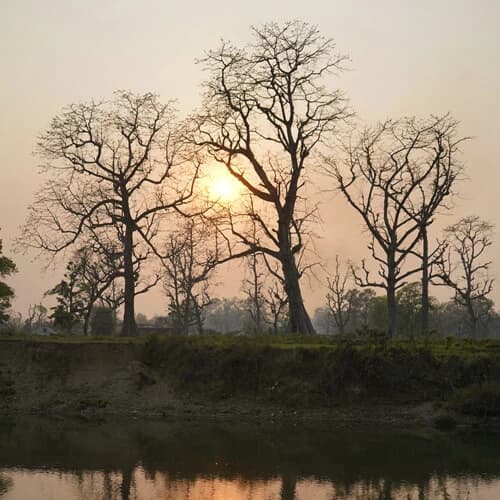Mt. Baruntse Expedition Highlights
- Surreal views of Mount Everest, Nuptse, Lhotse, and Makalu.
- Incredible once-in-a-lifetime journey through the remote and isolated valleys.
- An excellent peak to climb and gain mountaineering experience.
- Traverse the serene Everest/Khumbu region and Amphu Labtsa Pass.
- Walk through traditional Sherpa villages and immerse yourself in their culture and lifestyle.
- Walk through the dense forests of Makalu Barun National Park and witness elusive plant and animal species.
- Capture stunning pictures of the Himalayas and incredible landscapes from scenic vantage points.
Baruntse Climbing Expedition in the Beautiful Himalayas of Nepal
Baruntse Peak (7,129 meters (23,389 feet)) is one of the best accessible mountains in Nepal's remote Khumbu region for climbing expeditions above 7,000 meters. It offers a unique opportunity for climbers preparing for 8,000-meter mountains. The peak is located in eastern Nepal, surrounded by Mount Everest (8,848M), Lhotse (8516M), and Makalu (8463M). The magical peak is adorned by the Hunku Glacier in the south, Barun Glacier in the east, Imja Tse Glacier in the northwest, Num Ri, and Cho Polu in the north.
It is important to note that prior alpine/mountain climbing experience is required to conquer the peak safely and successfully. Participants must be in good physical and mental condition and knowledgeable regarding mountaineering skills and techniques needed to handle the climbing equipment. The journey begins with a thrilling and scenic flight from Kathmandu to Lukla or Kathmandu to Manthali, Ramechap by road, and from Manthali airport to Lukla. The flight route depends on the season you are traveling and the weather conditions on the scheduled date of the trip.
The Baruntse Climbing Expedition takes you to the Everest region's traditional villages, settlements, and beautiful valleys. Moving ahead, the trail passes through the Makalu Barun National Park, a scenic conservation area rich in unique flora and fauna. You will then transition from subtropical terrains to alpine winter wonderlands of the high-altitude landscapes. According to the experiences of previous mountaineers, the Southeast Ridge (standard route) of Baruntse Peak is significantly more difficult because of its direct approach to the steep climb. Moreover, multiple sections with a 50-degree slope and ice cliffs require technical climbing skills.
Regardless of the challenging nature of the Mount Baruntse Expedition, with the assistance of our guide and veteran climbing Sherpa, summiting the peak of Baruntse is achievable. Our staff members are well-informed and experienced in mountain expeditions above 7,000 meters. They have been in this field for two decades and will provide you with the needed practical information and precautions to tackle any challenges. Their hard work, dedication, and commitment significantly increase your confidence and courage, enhancing the travel experience.
Historical Significance Of Baruntse Peak Climbing
The mighty Baruntse saw its first climb on May 30, 1954, by a Kiwi Party led by Sir Ed Hillary. His team was formed by Bill Beaven, Colin Todd, George Lowe, and Geoff Harrow. The route pioneered by this expedition group through the "South East Ridge" is the standard route to today's peak. Their achievement marks the beginning of mountaineering on Baruntse in the Everest region of Nepal.
Several decades later, a Spanish expedition led by Juan José Díaz Ibañez made the first ascent of Baruntse through the East Ridge. Climbers including Javier Escartin, Lorenjo Ortas, Carlos Buhler, and Jeronimo Lipes contributed to this feat. However, not every expedition has been successful in reaching the summit. One such incident happened in 2010, when Mountaineer Chhewang Nima lost his life during the attempt.
The unfortunate event reminds us that the rewarding nature of the expedition comes with potential risks and challenges. As a result, it becomes pivotal to prepare correctly and have the right climbing skills and techniques to conquer the astonishing peak. Over the years, the Baruntse Climbing Expedition has attracted climbers, mountaineers, and adventurers who aim to conquer its height while respecting its challenges and glorious history.
Baruntse Expedition Climbing Route and Strategy
The route to the summit of Mount Baruntse in Nepal is a straightforward ascent on an ice and snow landscape with few steep cornice sections. You will spend the night at two additional high camps above Baruntse Base Camp (5,250m) to allow time for acclimatization. The base camp is located in a broad open valley on the lateral moraine of the Hongu Glacier. From Baruntse Base Camp, we ascend to the southeast ridge towards the West Col. The climb is made with the help of a fixed line to pass the challenging 50° ice cliff to the West Col, which leads us to Baruntse High Camp I at a glacial plateau.
From here, we ascend a long, low-angled glacier from Baruntse High Camp I using a fixed rope. As we approach the Baruntse Camp II, the icy slope steepens near a small col on the Southeast Ridge. As of today, we begin rotation climbs and only push for the summit when the weather is suitable for climbing. On the summit day, our climb starts by crossing a short, steep 5° ice wall to a small col, 6500m. Please be aware of the steep steps on the icy sections and always maintain careful footing to avoid slips. Moving ahead, we climb a sharp ice shoulder at an elevation of 7,000 m, which leads us to the summit ridge. Our climbing Sherpa will assist in fixing the ropes to ensure safety during the ascent and descent.
The broad ridge narrows closer to the Baruntse Summit at 7,219 meters. We cherish our achievement from the summit, soaking in the surreal panoramic views of Mount Everest, Cho Oyu, Lhotse, Kanchenjunga, Ama Dablam, and Makalu. It takes approximately 10 to 12 hours on average to complete the summit ascent of Mount Baruntse. After completing a successful climb, we gradually retraced our steps back to the same route as the Base Camp. After descending from Baruntse, the path leads us towards the stunning Amphu Labtsa Pass and returns to Lukla. On the way, we pass by several famous villages in the Khumbu/Everest region, such as Dingboche, Tengboche, and Namche.
Route Options for Baruntse Expedition
- Hinku Valley Route: The route starts with a scenic flight to Lukla, a popular choice for this high-altitude Himalayan journey. Upon arriving at Tenzing-Hillary Airport, you will trek through the beautiful Hinku Valley through remote villages and dense forests. As the trail ascends higher, the expedition leads to the challenging Mera La Pass. We then head towards Seto Pokhari Camp and Baruntse Base Camp for the final climb. This route offers a perfect blend of cultural experiences, natural beauty, and acclimatization, making it a well-rounded choice for enthusiasts who want to summit Baruntse Peak.
- Jiri Approach: This is an alternative way to begin the Baruntse Climbing Expedition, where the trek starts from Jiri. It gives travelers a unique experience and perspective of the Everest/Khumbu region. The journey begins as you follow the trek classic trail from Jiri to Everest Base Camp, which then connects with the Hinku Valley route. The trek from Jiri provides a longer and more gradual acclimatization process, which is beneficial regardless of your experience. Eventually, travelers will arrive at the high base camps, where they prepare for the challenging ascent to the Baruntse Peak. Overall, this route allows climbers to explore less-visited areas of the Everest region while achieving their ultimate goal of reaching the summit.



